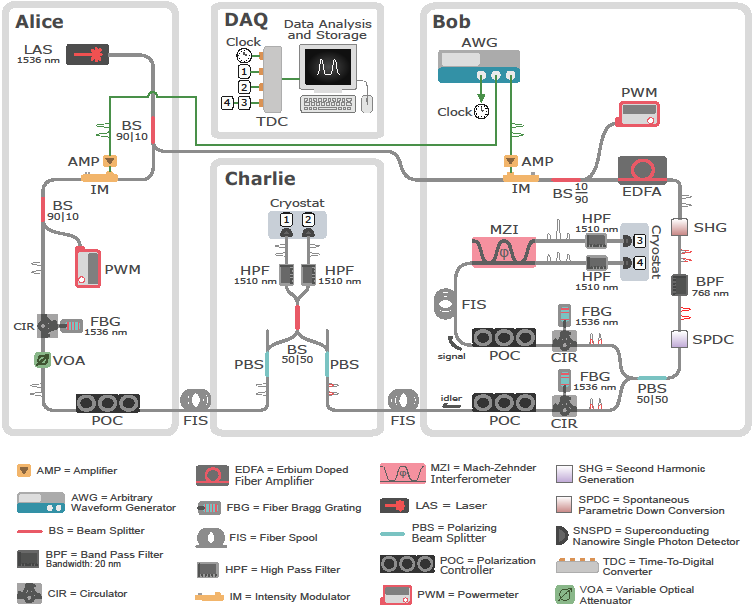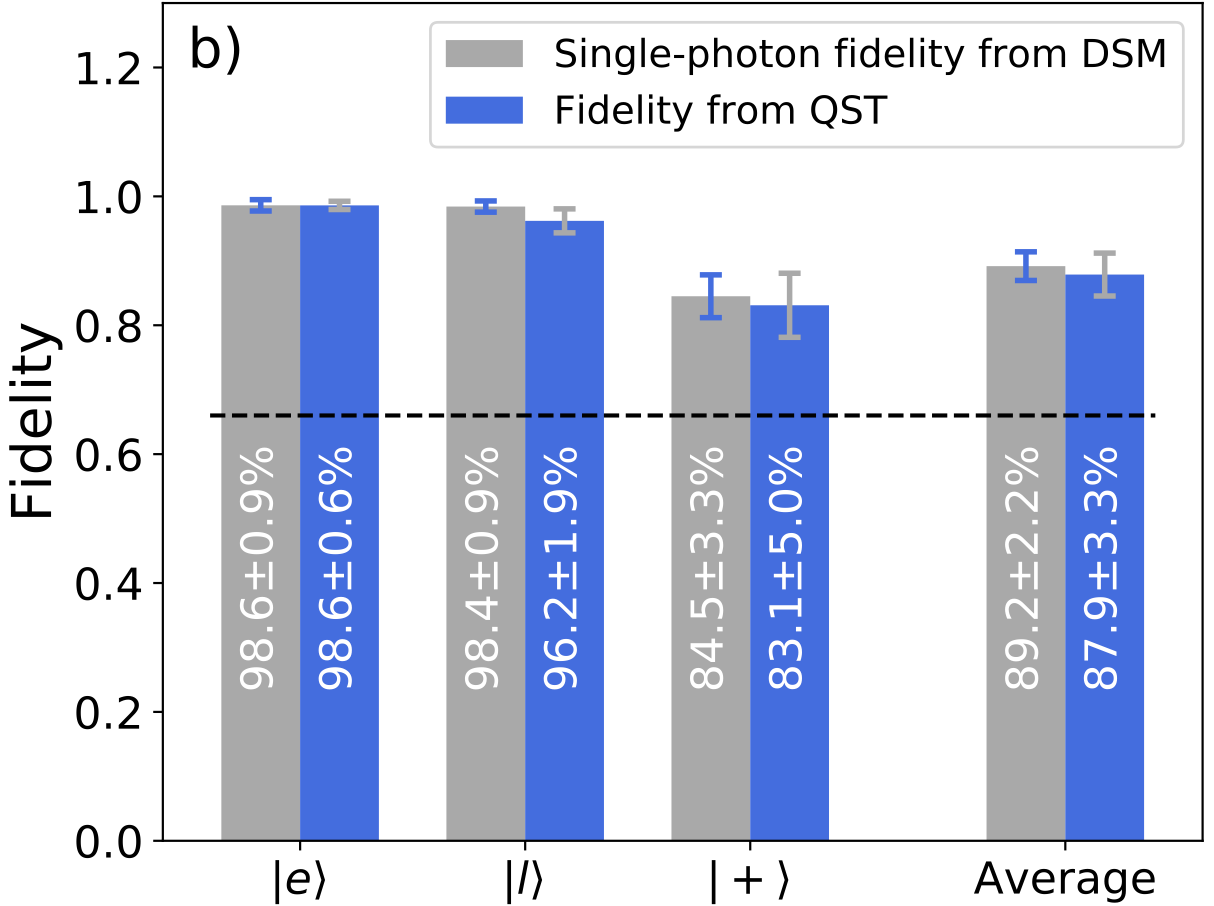Science Briefing
“Teleportation Systems Towards a Quantum Internet”
PRX Quantum, Dec. 4 2020, DOI:https://doi.org/10.1103/PRXQuantum.1.020317
On high fidelity quantum teleportation for practical quantum networks

Quantum teleportation is a “disembodied” transfer of quantum states from one location to another. It is one of the most intriguing, and consequently one of the most popularized, predictions of quantum physics. Since its first demonstrations over 20 years ago (see https://doi.org/10.1038/37539 and 10.1126/science.282.5389.706), it has been realized and studied in various physical systems and under diverse conditions. Beyond fundamental physics interest, it plays a central role in actualizing quantum information technology, including quantum computers and quantum networks. In this context, quantum teleportation of quantum bits (qubits), the basic unit of quantum information, is essential.
For quantum networks, quantum teleportation and entanglement swapping are used to distribute quantum information between distant locations. This process allows the realization of quantum cryptographic schemes or distributed quantum tasks, such as sensing or computing. Importantly, quantum teleportation is vital in order to extend the distance of quantum networks using quantum memories and quantum repeaters. This development will form part of a global quantum network: a so-called Quantum Internet.
In particular, the quality of teleportation, referred to as the fidelity, characterizing the proximity of the teleported qubit to the original, has become increasingly crucial as quantum technology matures. This high fidelity is important especially in the case of quantum networks designed to connect advanced quantum devices, including quantum sensors.
Teleportation and systems towards a Quantum Internet
In the paper “Teleportation systems towards a Quantum Internet”, a joint team of researchers from Caltech, Fermilab, NASA JPL, Calgary, Harvard, and AT&T demonstrate quantum teleportation of qubits of photons (quanta of light) with a fidelity greater than 90%, using state-of-the-art single photon detectors and off-the-shelf equipment. A detailed analytical model, including experimental imperfections, supports the results and indicates that a workable and high-fidelity quantum network using practical devices can be built. The U.S. Department of Energy envisioned such an ambitious quantum network to link the Office of Science National Laboratories.
The team performed quantum teleportation of time-bin (or time-of-arrival of) qubits of light at the telecommunication wavelength of 1.5 microns. This approach is well-suited for photons that travel over low-loss fiber optics cables-- the same used by the telecommunication industry today. Time-bin qubits are compatible with several quantum devices, such as detectors, solid-state quantum memories, or transducers that store qubits. The team built two testbeds using fiber-coupled, commercially available equipment, one at Caltech (CQNET) and one at Fermilab (FQNET), allowing straightforward replication and deployment of quantum networks.
To demonstrate the deployability, teleportation is performed with up to 44 km of fiber optics cable between the qubit generation and the teleported qubit’s measurement. It is facilitated using semi-autonomous control, monitoring, and synchronization systems. Data is collected using scalable data acquisition hardware and software, and results are derived near-real time. The networks run remotely for long periods, up to a week at a time, without human intervention.
Quantum teleportation of a qubit is achieved using quantum entanglement. Entangled states are formed of at least two qubits, each of which cannot be described faithfully separately. Teleportation is commonly depicted as a user scenario or protocol where Alice has a qubit that she wants to teleport to Bob. Bob generates an entangled two-qubit state, keeps one for himself, and sends the other to Alice, who performs a joint measurement on this qubit and her own. The measurement outcome, which is classical and reveals nothing about any of the qubits, is sent to Bob by legacy means, e.g., a phone call. Bob recovers Alice’s qubit by rotating it according to this result, or conversely, orienting his measurement apparatus when he wants to use the qubit for a task.
Experimental Setup
Figure 2 illustrates the experimental setup of the teleportation testbeds built, where an additional user, Charlie, performs the joint measurement for Alice, a common scenario in quantum network systems in order to achieve longer distance teleportation. Alice, indicated by the box on the left, prepares the time-bin qubit and sends it to Charlie through fiber wound in a spool. Bob prepares time-bin entangled qubits (box on the right), sending one qubit to Charlie (middle) using a second fiber spool. Charlie performs the joint measurement, while Bob verifies the teleportation by measuring the remaining qubit. The data acquisition (DAQ) system collects all measurement outcomes for analysis.

Results
The measured teleportation fidelities are shown in Figure 3. Researchers teleported the so-called “early” and “late” qubits, photons generated earlier or later than the other, and quantum superposition states of early and late. These qubits are specifically chosen and are used as the basis of more complex qubits. Two different methods extract fidelity. The first uses “quantum state tomography”. Bob performed several measurements of the teleported qubit over different runs of the experiment to reconstruct and compare it to that accomplished through ideal generation and teleportation. The second method is based upon the technique of “decoy states”, an approach known from quantum cryptography. Since the qubits generated by Alice are not based on single photons, instead obtained from very weak laser pulses that contain potentially many photons, this method allows estimating the teleportation fidelity of the experiment as if Alice uses single photons. This step is crucial for evaluating the teleportation fidelity since the most commonly used method assumes qubits encoded into single quantum systems, in this case, photons.

Outlook
The analytical model and detailed measurements of the teleportation fidelity and rates presented in this work suggest that straightforward improvements in the design specifications of the devices and equipment used can bring orders-of-magnitude improvements in rates, and achieve near-unity fidelity. The team is working on the systems upgrades and integration of additional quantum devices at the edges and in the quantum interconnects.
LINKS
Team Video (2 m 32 s)
CQNET footage (37 s)
FQNET footage (38 s)
INQNET-Caltech Press Release
Acknowledgments
R.V., N.L., L.N., C.P., N.S., M.S., and S.X. acknowledge partial and S.D. full support from the AQT IN-Q-NET research program. R.V., N.L., L.N., C.P., N.S., M.S. S.X., and A.M. acknowledge partial support from the U.S. Department of Energy, Office of Science, High Energy Physics, QuantISED program grant, under Award No. DE-SC0019219. A.M. is supported in part by the JPL President and Director’s Research and Development Fund (PDRDF). C.P. further acknowledges partial support from Fermilab’s Lederman Fellowship and Lab Directed R&D (LDRD). D.O. and N.S. acknowledge partial support from the Natural Sciences and Research Council of Canada (NSERC). D.O. further acknowledges the Canadian Foundation for Innovation, Alberta Innovates, and Alberta Economic Development, Trade and Tourism’s Major Innovation Fund. J.A. acknowledges support by a NASA Space Technology Research Fellowship. Part of the research was carried out at the Jet Propulsion Laboratory, California Institute of Technology, under a contract with the National Aeronautics and Space Administration (80NM0018D0004). We thank Jason Trevor (Caltech Lauritsen Laboratory for High Energy Physics), Nigel Lockyer and Joseph Lykken (Fermilab), Vikas Anant (PhotonSpot), Aaron Miller (Quantum Opus), Inder Monga and his ESnet group at Lawrence Berkeley National Laboratory (LBNL), the groups of Wolfgang Tittel and Christoph Simon at the University of Calgary, the groups of Nick Hutzler, Oskar Painter, Andrei Faraon, Manuel Enders, and Alireza Marandi at Caltech, Marko Loncar’s group at Harvard, Artur Apresyan and the HL-LHC USCMS-MTD Fermilab group; Marco Colangelo (MIT); Tian Zhong (Chicago); and AT&T’s Soren Telfer, Rishi Pravahan, Igal Elbaz, Andre Feutch, and John Donovan. We acknowledge the enthusiastic support of the Kavli Foundation on funding quantum information science and technology (QIS&T) workshops and events and the Brinson Foundation support, especially for students working at FQNET and CQNET. M.S. is especially grateful to Norm Augustine (Lockheed Martin), Carl Williams (NIST), and Joe Broz (SRI, QED-C); Hartmut Neven (Google Venice); Amir Yacoby and Misha Lukin (Harvard); Ned Allen (Lockheed Martin); Larry James and Ed Chow (JPL); the Quantum Communication Channels for Fundamental Physics (QCCFP) wormhole-teleportation team, especially Daniel Jafferis (Harvard) and Alex Zlokapa (Caltech), Mark Kasevich (Stanford), Ronald Walsworth (Maryland), Jun Yeh and Sae Woo Nam (NIST); Irfan Siddiqi (Berkeley); Prem Kumar (Northwestern), Saikat Guha (Arizona), Paul Kwiat (UIUC), Mark Saffman (Wisconsin), Jelena Vuckovic (Stanford) Jack Hidary (former googleX), and the quantum networking teams at Oak Ridge National Laboratory (ORNL), Argonne National Laboratory (ANL), and Brookhaven National Laboratory (BNL), for productive discussions and interactions on quantum networks and communications.